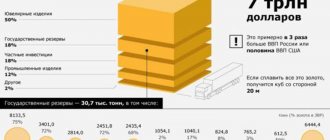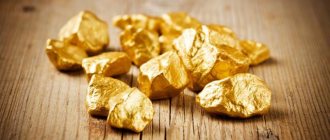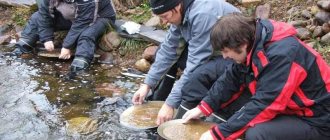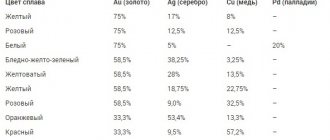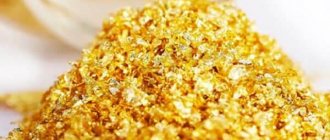Mining is an activity aimed at extracting mineral-containing substances from the depths of the earth or from its surface and processing them to obtain finished products. Gold mining is a priority in this area. This is largely due to the preciousness of the metal and its influence on the state of the gold and foreign exchange reserves of any country. Therefore, the gold mining industry occupies a special place in the system of state development, and new technologies are being developed and implemented to improve it.
The process of gold formation in nature
Gold deposits
Precious metals are found everywhere in nature, including the world's oceans and even plants, but there are no sufficiently effective methods for extracting them. Therefore, gold mining is carried out in deposits that are of two types.
Primary, called radical - their formation is associated with magmatic activity, when many molten components erupt to the surface of the earth, including gold-containing salt solutions, solidifying into veins.
Secondary, called alluvial - they are formed as a result of the release of precious metal from gold ore under the influence of natural processes (river flows, the appearance of ravines, rock falls) or climatic disasters (floods, mudflows, heavy rains).
When water erodes gold-bearing veins, it can carry particles of the yellow metal over considerable distances. Especially large pieces are called nuggets. Their weight varies from 5 grams to several kilograms.
There will be more and more gold in the coming years
Unlike black gold (oil) or blue gold (natural gas), which, after extraction from the subsoil, are irretrievably consumed in economic processes, gold itself has been accumulated for several millennia in the form of archaeological artifacts, jewelry and household items, numismatic and commemorative coins, measured and bank bars. In the last decade, a relatively new trend of large-scale purchases of gold by the central banks of a number of countries, primarily Russia and China, has emerged, apparently as part of the strategy of de-dollarization of the financial sector.
The Central Bank reported that at the end of 2021, Russia remained in fifth place in the world ranking in terms of the amount of gold in international reserves, increasing the gap from China. Over the past year, the Bank of Russia increased its monetary gold reserves by 159 tons, to 2,271 tons (73 million troy ounces). During the year, he regularly purchased it to replenish gold and foreign exchange reserves. However, the distance in terms of gold reserves between Russia and the leaders of the world ranking is still very large: the USA has 8134 tons, Germany has about 3370 tons.
According to the World Gold Council (WGC), purchases of gold by the world's central banks continued actively in 2021 and in January-September increased by 12% compared to the same period of the previous year, to 547.5 tons. Thus, at the end of 2019, the record for gold purchases by central banks is expected to be updated. In 2021, a 50-year record was set - 651.5 tons.
Russia remains the largest buyer of gold—in 2021, it accounted for more than 20% of all purchases of this precious metal for countries’ reserves.
Global gold consumption, according to WGC, exceeds 4,300 tons per year; over the past 40 years, consumption has almost tripled. Two-thirds of the gold entering the world market is provided by gold mined from the ground. At the same time, global gold production is also increasing. In 2021, according to Gold Fields Mineral Services (GFMS), it was over 3,300 tons, almost double the level of the mid-1980s. Therefore, the issues of forecasting gold production in the world and the sufficiency of the mineral resource base to meet the current and projected needs of the world economy are relevant, including for the sustainable development of the mineral resource base of gold in Russia as one of the leading producers of gold in the world.
Lyudmila Dorozhkina, leading specialist of the Information and Analytical Center for Subsoil Use, part of the Federal State Budgetary Institution All-Russian Research Institute of Mineral Raw Materials named after. N.M. Fedorovsky,” told Kommersant-Science about what to expect from the gold market.
— What are the principles for forecasting gold production?
— The forecast of gold production in the world is part of scientific research work, the purpose of which is to analyze the provision of the world economy with resources of the most important types of solid minerals and forecast the production of mineral raw materials in the foreseeable future. At the end of 2021, the Federal State Budgetary Institution VIMS published the monograph “Extraction Capabilities of the Subsoil”. The book presents the results of an analysis of the resource supply of the world economy for the most important types of solid minerals - ferrous, non-ferrous and precious metals.
The forecast is based on information about reserves, resources, actual production, as well as the design production capacities of fields in operation and those being prepared for production. The production capabilities of deposits represent the provision of each of them with mineral resources at a given level of production, which is calculated in accordance with the work plan of the owner company.
Information is collected and updated during monitoring of the state of the global gold mineral resource complex. To date, the analysis uses information from more than 1,500 primary deposits. This included the overwhelming majority of primary gold deposits in the world, including almost all unique, large and most medium-sized objects, as well as a significant part of complex deposits with associated gold.
Gold reserves and resources have been identified in more than 100 countries around the world. According to our estimates, the world's industrial reserves of gold reach 63 thousand tons, and total resources exceed 120 thousand tons. Global production of the precious metal is growing and amounted to 3.3 thousand tons in 2021, according to the US Geological Survey. According to the results of an analysis of production capabilities, the growth trend will continue in the coming years, and a maximum of 3.4 thousand tons will be reached by 2022. However, from 2025, a steady decline in global production is possible, and by 2030 it could decrease to 2.7 thousand tons, that is, by about 20% compared to 2018.
Gold production in Russia in 2021 amounted to 378 tons. Currently, over 40 projects for the development of fields of various sizes are in development. The largest of them are Sukhoi Log in the Irkutsk region, Nezhdaninskoye in the Republic of Sakha (Yakutia), and Peschanka in the Chukotka Autonomous Okrug. If all developed facilities are brought into operation in a timely manner by 2030, gold production in Russia may exceed 450 tons.
— How does the forecasting technique (VIMS) differ from foreign analogues, for example GFMS?
— Analytical companies working in the information space of the gold industry, such as Gold Fields Mineral Services, as a rule, cover issues of its supply and consumption on the world market, price dynamics, global trade, etc. At the same time, issues related to mineral resource base of gold and its extraction. On the contrary, our work is carried out precisely in this direction. Data on reserves and production (both actual and design capacity) of each specific deposit allows us to create samples according to given parameters and use them to assess the possible dynamics of mineral production in individual countries and in the world as a whole, to assess production capabilities by leading geological industrial types of deposits, the rate of resource depletion of currently exploited facilities, etc.
— What is the accuracy of your forecasts?
— It should be noted that any forecasts, including forecasts of total gold production, are probabilistic in nature and depend on many conditions. Thus, when analyzing the production capabilities for each of the fields being developed, the stage at which the development project was located was taken into account. As a rule, projects with a high degree of preparation have a significantly greater potential for implementation than projects at an early stage, that is, preliminary assessment. The latter may be mothballed or their completion delayed due to unfavorable market conditions. The mothballing of a development project does not affect the resource potential of the deposit being developed, but has an impact on the expected level of mineral production as a whole.
— How much do you think the price of gold will change by 2030?
— Changes in fundamental factors (decrease in gold production, reduction in gold reserves of highly profitable deposits, etc.) influencing the formation of prices in the future should support a positive cost trend for gold, and its price may exceed $1.5–1.6 thousand per troy ounce
However, it should be noted that since the 2000s, there has been a sharp complication of the cause-and-effect relationships that shape world prices for raw materials, and the task of forecasting world prices for gold, taking into account only the action of traditional fundamental factors, is becoming increasingly more difficult, since both financial factors.
— Is it possible to develop the methodology used for forecasting, for example, with the inclusion of artificial intelligence blocks?
— Of course, the methodology used for forecasting can be modified, including with the inclusion of machine learning blocks, for example, in terms of analyzing the likelihood of implementing projects that are at different stages of study.
Prepared by Vladimir Teslenko, Candidate of Chemical Sciences
Methods for extracting precious material from nature
Humanity has long been engaged in the search and development of precious metals, but despite this, gold mining for a long time was carried out using primitive methods, which, although rarely, are used in the modern world. They are called "traditional".
With the development of mechanical engineering and the growth of scientific and technological progress, many new methods for extracting gold have appeared, which are considered “modern”. They are a mechanized process and have the nature of industrial developments.
The process of extracting the yellow metal is not limited to digging it, cutting it down, or washing it out as part of the gold ore. The ability to isolate gold from blocks of rock and accompanying minerals is of great importance.
Manual sieving and washing method
Currently, this type of mining is considered artisanal and is rare, although it is one of the most ancient. It involves passing river sand through a sieve, wooden tray or burlap. In gold-bearing rivers, prospectors scoop up river sand and, pouring it onto a device, sift and wash it. Precious metal particles, which are larger in size than ordinary grains of sand, remain in the dish and are collected in a separate container.
Such work is very complex, painstaking, and requires a lot of effort and time. In addition, it involves prolonged exposure to water, which is also an additional negative factor. However, the result cannot be predicted in advance.
Mechanized mines
Modern technologies make it possible to facilitate the work of miners by mechanizing most of the processes of sifting and washing river soil. Dredgers, pumps, screens and other mechanisms make it possible to lift sand from great depths, deliver it to the shore and process it in a shorter period of time and with less labor than when working by hand.
But, despite a significant reduction in manual labor, its percentage in the gold mining process remains high. Therefore, work in the mines is still considered one of the most difficult.
Extracting gold from ore
Extracting gold from ore
Previously, such mining was carried out manually and was always associated with a great risk to the life and health of the gold miner, because it was accompanied by digging mines, the presence of landslides and collapses, or staying in mountainous areas.
Now this practice of obtaining gold has been stopped, and the development of gold ore is carried out using a mechanized method. The rock is extracted from a mine or quarry using powerful equipment, after which it is crushed and sifted in special mechanisms.
Quite often, to speed up excavation, gold mining sites use explosive and drilling and blasting methods, which makes it possible to produce and process larger volumes of rock in a short time.
Gold mining equipment
Gold miners are forced to use a large number of different equipment, which is divided depending on the purpose of its use:
- for drilling equipment for mineral exploration - installations, machines, bits, bits, drill bits;
- for other equipment for exploration, for example, concentrators, trays, washing devices, sieves, sluices;
- for mining equipment, which includes drilling rigs, pumps, pipes
- for equipment for open-pit mining and underground work;
- for processing equipment for placers, which includes dredges and washing devices, etc.
Until recently, gold deposits were located very close to the surface of the earth, so they were easily extracted, which made it possible to mine gold manually. Quite often one could find a nugget on the river bank - a stone consisting of an ingot of pure metal. Prospectors then wandered along the rivers with trays in order to pan for gold in the easiest way. Now the panning process is becoming popular again and people want to know how to pan for gold again. To help such prospectors, Russian and foreign manufacturers offer modern equipment for searching and extracting yellow metal.
Thus, they have created various devices for washing gold with a productivity of 4 m³/hour to 20.0 m³/hour, which makes them very convenient for organizing small-scale mining. To wash metal, such an industrial device is installed permanently using support jacks.
Almost every year there is information that a new washing device has been developed for alluvial gold. Some Russian manufacturing companies claim that their industrial devices make it possible to extract gold without losses due to a closed mining cycle, since the industrial washing device has a special tank for circulating water, which allows the miner to work away from the reservoir.
The industrial device for gold mining can be used on both a small and industrial scale. It can be bought in specialized stores or on the Internet, or rented.
Recently, the popularity of the method of searching for gold using metal detectors has been growing, since this method is accessible even to children, women or pensioners. It allows you to get a nugget weighing from 2 to 20 g.
Dredges and mini-dredges
There are various options for drag on the equipment market. Minidrags with a productivity of 1.5 to 20 m³/hour have been used by miners abroad for more than 30 years on placers in Alaska, South Africa, Canada and America. There are especially many options for drags offered by Chinese manufacturers. Some dredges have sensors for precious metals, can provide light signals for the presence or absence of gold in the pulp, and are also able to plot the correspondence of the location of the search for the precious metal with its concentration in the rock.
Accumulations of the noble metal are also located in deep areas of the river bed, because it is a heavy metal. Such clusters are called nests or cauldrons. In these places, the gold content can reach hundreds of grams per cubic meter of water. Portable electric suction dredges have been developed especially for such underwater deposits, operating silently from an electric motor, and these mechanisms are invisible even from the air.
There are other good devices for washing, sorting and mining gold, for example, the American Goldfield Explorer 2. However, it should be borne in mind that in the context of sanctions and a difficult international situation, it is wiser to use Russian mechanisms, for which it will not be a problem to find spare parts or a repair shop for equipment.
Methods used to separate gold from the total output mass
The gold mining industry divides deposits according to their profitability, based on the amount of precious metals per certain volume of processed soil:
- 10 gr. per ton of rock/sand – rich;
- 3 grams of gold per ton is profitable.
Every year there are fewer and fewer rich deposits in the world, so much attention is paid to the ability to isolate gold with the least loss from the total processed rock mass. There are quite a lot of such methods.
Amalgamation
This method is based on the use of mercury to separate the precious metal from the ore mass. Mercury has the ability to attract gold particles, enveloping them. The gold extraction process consists of several stages:
- Using the peculiarity of mercury, it is placed in special containers, into which the rock is then poured.
- The noble metal is literally removed by mercury from the general contents of the container, after which the devastated rock is removed.
- To free the yellow metal from the embrace of the white, the container heats up and delamination occurs on its own.
The amalgamation method was widely popular, but was gradually replaced by more progressive and safer methods for obtaining gold that did not involve the use of highly toxic mercury.
Heap leaching
At the moment, this is the most widely used and highly productive method, allowing the extraction of gold even from previously processed ore, as well as from rocks recognized as low in precious metal content. The use of sodium cyanide ensures the conversion of gold particles (even the smallest ones) into cyanide compounds. Subsequently, with the help of chemical reactions, the metal is separated and purified from impurities.
This gold leaching technique makes it possible to more completely process gold ore and makes new use of old deposits and previously abandoned developments feasible.
Method of etching gold from products
Etching gold from products
This method is not industrial, but is used in extracting precious metals from old radio components, gold-plated products for household and household purposes. The etching method is based on the chemical inertness of the desired element. To achieve success, it is necessary to collect a large batch of the above items, separate the gold-containing elements and place them in a solution of concentrated nitric and hydrochloric acid, called “aqua regia”.
A special feature of this solution is the ability to dissolve all metals except gold without residue, so the result will be a gold film on the surface of the liquid. It can be separated using regular cloth.
How gold is mined
Gold has been valued as a precious metal for six and a half millennia. This unique substance became a symbol of luxury and the equivalent of wealth in the 3rd millennium BC. The chemical name of the element in the periodic table is Aurum, this term is translated into Sanskrit as yellow, in the Latin interpretation of the translation the word sounds like Aurora or the Goddess of the Dawn. This element is rare in nature, so its extraction involves a lengthy search for deposits and a labor-intensive process of extracting gold from ore and bulk rocks. Large nuggets of metal found throughout the Earth can be counted on one hand.
How are gold veins found? Gold is a mineral resource that is developed in several stages:
- Exploration of the deposit and delineation of the site for future developments.
- Economic assessment of deposit volumes.
- Excavation of deposit sites and creation of initial infrastructure for industrial development.
- Extraction of gold-bearing rocks - ore, sand and extraction of precious metal from them.
Exploration and prospecting work is carried out by studying rock outcrops, examining cores recovered during well drilling, and geophysical studies of strata. Geologists often determine the zone of possible gold-bearing rocks by accompanying minerals. These include chalcopyrite, pyrite, sphalerite, galena, arsenopyrite, stibnite, and brown ironstone. The main mineral that geologists look for when searching for gold is quartz. It is in quartz veins that gold inclusions are most often found. The satellites of gold ore are rocks - diorites and granites. They are formed under the same conditions in the depths as gold-bearing rocks, that is, when magma rises to the surface and cools in the upper layers of the earth's crust.
Types of gold deposits
Bedrock or ore deposits
The first deposits of the precious metal are considered to be primary or ore deposits. It is from them that gold placers are formed during the destruction of strong conglomerates from rocks. Subsequently, rock fragments are transported by water flows, this explains the presence of gold in the channel valleys of small rivers. Such a placer is called alluvial and is considered the most promising for development.
Eluvial deposit
An eluvial deposit is a placer of debris and sand that has not been transported. They lie where the gold-bearing rock has been destroyed; they are usually found on the watersheds of large water arteries. This type of deposit is in second place in terms of gold content.
Colluvial placer
A colluvial placer is a mass of fragments with gold-bearing inclusions that has slid down from the slopes of mountains. It is always located below the primary deposit, so before laying mines, additional exploration is carried out and the height in the mountains is found where gold-bearing strata lie. Economically, these deposits are considered low-profit.
Extraction of gold from ore and its subsequent processing
The development of gold deposits is carried out using open and closed methods. open pits are quarries in which drilling and blasting operations are carried out to create ore dumps, which are subsequently transported to mining and processing enterprises; closed - these are mines leading to underground deposits from which gold ore is extracted.
The second is more expensive, since the operation of the mechanisms in the mine requires additional energy, special mechanisms and equipment, and the cost of paying for dangerous working conditions for miners.
Ore processing
Ore processing consists of grinding it to the smallest fractions (into sand) and adding cyanide solution to them.
This substance leaches gold particles, the rock settles, and the gold is released and removed along with cyanide from the rock mass. Cyanide leaching can be of two types: with ore grinding, as described above, and heap leaching. In the second option, the ore is not crushed, but cyanide is poured onto the rock pieces.
This process of gold separation is longer, and the share of gold produced from ore is much lower than in the first option. If 95% of the total gold contained in ore can be extracted from the sand fraction, then only 65% can be extracted from rock pieces. The advantage of heap leaching is the lower cost of the treatment process.
Gold producing countries
Gold is not mined in all countries. This is due to the rarity of this element in nature, as well as the complexity of industrial extraction technologies. Previously, the most gold-producing countries were the USA and Canada, then China became the vanguard (it produces about 13% of the world's reserves). The list of the main gold-mining countries is as follows - China, Australia, South Africa, USA, Russia, Peru, Uzbekistan.
Production processes in the production of precious metals
The heap gold leaching method involves a number of production processes, the result of which is the yield of a pure precious product:
- after delivering the gold ore to the processing plant, it is placed in mills, where it is crushed to a certain fraction;
- after this, the material is passed through sieves and goes through a pelletizing stage, which prevents the factions from sticking together into large compounds;
- then the resulting mass is sent for leaching with sodium cyanide and formed into an ore pile;
- the next step is the separation of waste ore from metal cyanide compounds by sorption;
- the extracted gold-containing compounds are sent for galvanization, where preliminary purification occurs.
The completion of the process is the melting of the resulting sediment until the alloy is released, which is subsequently leached from ore residues.
Gold mining in the cold season
It is easier to mine gold in the cold season than in summer
Most miners would prefer gold mining in the warm season, when the result promises to be more tangible and working conditions are much more comfortable. But in reality, searching for metal in winter or early spring has its advantages that cannot be ignored. The main thing is to know where to look. For this method, you must take hunting skis (not cross-country skis) for traveling over rough terrain.
It is much easier to detect and remove valuable metal in clean, clear water in winter than in summer. When searching, you need to take into account that river levels drop significantly in the cold months. Therefore, usually shallow places that are promising for searching during this period become even shallower and more accessible for exploration, and areas of rocks previously covered by water begin to be visible above its surface.
The advantage is the ability to notice yellow reflections simply on the surface of the rocks (an additional tool for beating off pieces of rock will be useful). In addition, in winter you can find the precious metal in larger quantities on the rocks than in the sand in summer.
The right place is the basis for a successful search for the treasure.
Passivity of private gold mining
Free miners are increasingly less likely to go in search of gold metal, the reason for this is the following circumstances:
- Technical. In the modern world, gold mining is the responsibility of large companies. This is achieved during the daily activities of mining and processing plants and the operation of special machines - dredges. Industrial gold mining is much more efficient and profitable than manual labor.
- Legal. Already from the end of the 19th century. The state began to restrict the work of gold miners of private enterprises, as well as individuals who wash gold on their own, without permission. For a long time, gold mines could only be legally exploited by large companies with a special license.
Is it possible to mine gold in Russia? So far, only large companies do this. Today, the private process of mining gold metal in Russia is considered a crime. He is punishable by law. The sentence may be increased if illegal gold mining is carried out by a group of persons. Many believe that in Russia it is necessary to introduce the practice of the USA and Canada, where, having purchased a license, anyone can independently mine the precious metal. Communication between large companies and private miners can significantly increase the productivity of the Russian Federation. The state is against gold being mined by individual miners in Russia, because... there is a high probability that this metal will pass by the state treasury.
You should not assume that man has discovered all the gold mines. There are unexplored expanses of water, such as the ocean, from which the precious metal can be mined.
